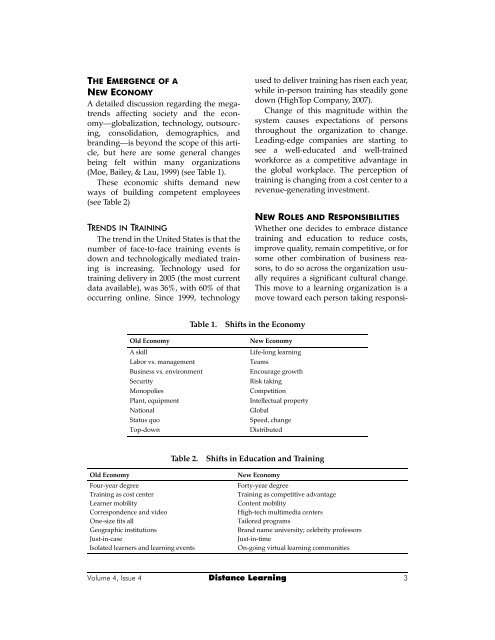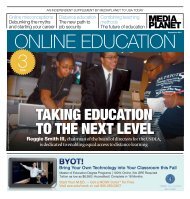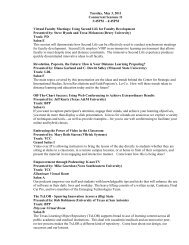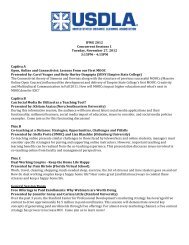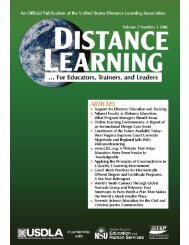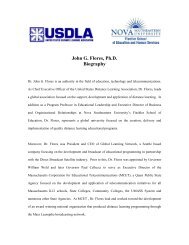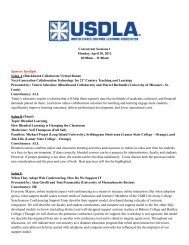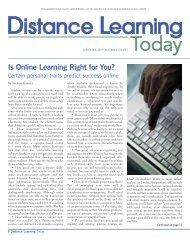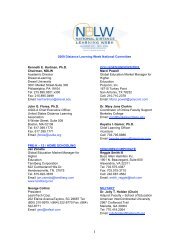United States Distance Learning Association
United States Distance Learning Association
United States Distance Learning Association
- No tags were found...
Create successful ePaper yourself
Turn your PDF publications into a flip-book with our unique Google optimized e-Paper software.
THE EMERGENCE OF A<br />
NEW ECONOMY<br />
A detailed discussion regarding the megatrends<br />
affecting society and the economy—globalization,<br />
technology, outsourcing,<br />
consolidation, demographics, and<br />
branding—is beyond the scope of this article,<br />
but here are some general changes<br />
being felt within many organizations<br />
(Moe, Bailey, & Lau, 1999) (see Table 1).<br />
These economic shifts demand new<br />
ways of building competent employees<br />
(see Table 2)<br />
TRENDS IN TRAINING<br />
The trend in the <strong>United</strong> <strong>States</strong> is that the<br />
number of face-to-face training events is<br />
down and technologically mediated training<br />
is increasing. Technology used for<br />
training delivery in 2005 (the most current<br />
data available), was 36%, with 60% of that<br />
occurring online. Since 1999, technology<br />
used to deliver training has risen each year,<br />
while in-person training has steadily gone<br />
down (HighTop Company, 2007).<br />
Change of this magnitude within the<br />
system causes expectations of persons<br />
throughout the organization to change.<br />
Leading-edge companies are starting to<br />
see a well-educated and well-trained<br />
workforce as a competitive advantage in<br />
the global workplace. The perception of<br />
training is changing from a cost center to a<br />
revenue-generating investment.<br />
NEW ROLES AND RESPONSIBILITIES<br />
Whether one decides to embrace distance<br />
training and education to reduce costs,<br />
improve quality, remain competitive, or for<br />
some other combination of business reasons,<br />
to do so across the organization usually<br />
requires a significant cultural change.<br />
This move to a learning organization is a<br />
move toward each person taking responsi-<br />
Table 1.<br />
Old Economy<br />
A skill<br />
Labor vs. management<br />
Business vs. environment<br />
Security<br />
Monopolies<br />
Plant, equipment<br />
National<br />
Status quo<br />
Top-down<br />
Shifts in the Economy<br />
New Economy<br />
Life-long learning<br />
Teams<br />
Encourage growth<br />
Risk taking<br />
Competition<br />
Intellectual property<br />
Global<br />
Speed, change<br />
Distributed<br />
Table 2.<br />
Old Economy<br />
Four-year degree<br />
Training as cost center<br />
Learner mobility<br />
Correspondence and video<br />
One-size fits all<br />
Geographic institutions<br />
Just-in-case<br />
Isolated learners and learning events<br />
Shifts in Education and Training<br />
New Economy<br />
Forty-year degree<br />
Training as competitive advantage<br />
Content mobility<br />
High-tech multimedia centers<br />
Tailored programs<br />
Brand name university; celebrity professors<br />
Just-in-time<br />
On-going virtual learning communities<br />
Volume 4, Issue 4 <strong>Distance</strong> <strong>Learning</strong> 3


